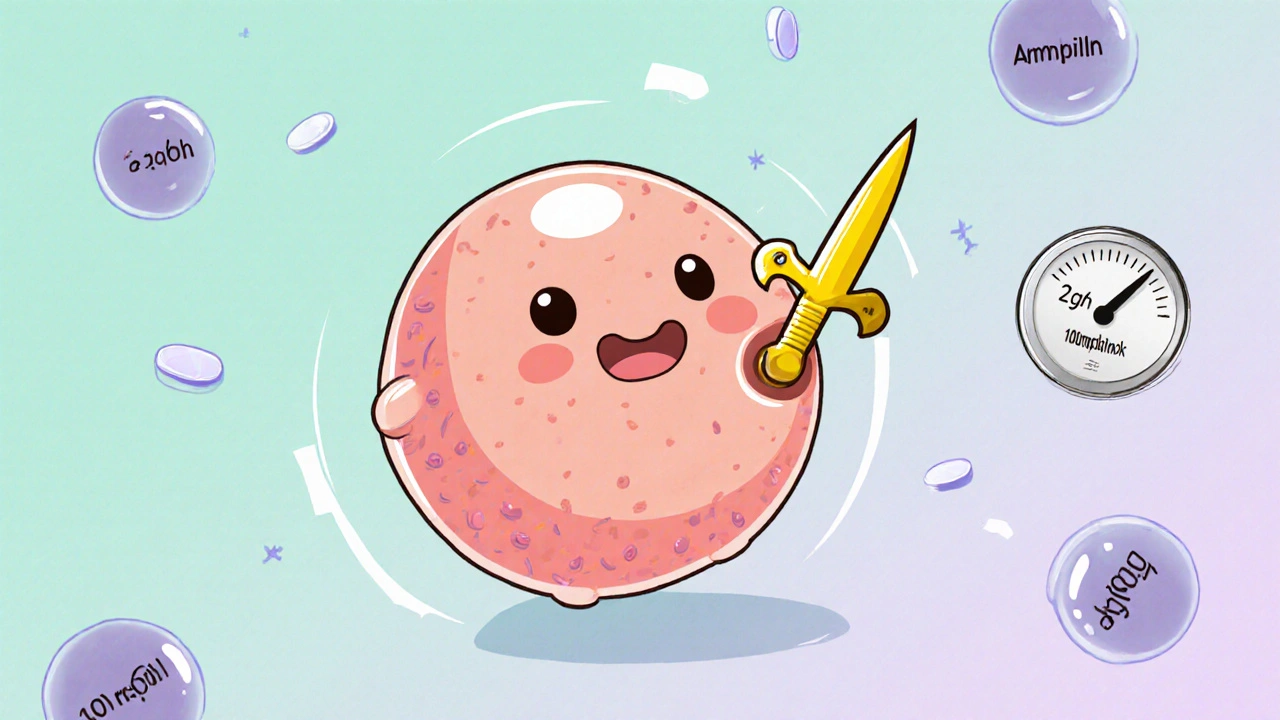Ampicillin Typhoid Fever Dosing Calculator
Dosage Information
Note: This calculator follows WHO guidelines. For severe cases, intravenous ampicillin may be required.
Important: Ampicillin effectiveness depends on Salmonella Typhi susceptibility. Always confirm resistance testing in your region.
Typhoid fever still haunts travelers and communities where clean water is scarce. While many antibiotics are tossed around, ampicillin remains a first‑line weapon in many parts of the world. This guide walks you through exactly how ampicillin works against the disease, the right dose for different ages, safety red flags, and why resistance matters today.
Key Takeaways
- Ampicillin is a beta‑lactam antibiotic that targets the cell wall of Salmonella Typhi, the bacteria that cause typhoid fever.
- Standard adult oral dose: 2 g every 6 hours for 10‑14 days; pediatric dose: 100 mg/kg/day divided q6h.
- Common side effects include nausea, rash, and mild liver enzyme elevation.
- Rising antibiotic resistance a reduced susceptibility of bacteria to drugs that once killed them limits ampicillin’s use in some regions.
- World Health Organization (WHO) still lists ampicillin as an alternative when susceptibility is confirmed.
What Is Ampicillin?
Ampicillin a semi‑synthetic, broad‑spectrum beta‑lactam antibiotic derived from penicillin. It interferes with bacterial cell‑wall synthesis by binding to penicillin‑binding proteins, leading to lysis of actively dividing organisms. First introduced in the early 1960s, ampicillin expanded the reach of penicillins beyond gram‑positive cocci to include many gram‑negative rods, such as Salmonella Typhi the causative agent of typhoid fever. Because it can be given orally or intravenously, clinicians have flexibility based on illness severity.
Typhoid Fever Overview
Typhoid fever an acute systemic infection caused by the bacterium Salmonella enterica serovar Typhi is transmitted through contaminated food or water. After an incubation period of 7‑14 days, patients develop sustained fever, abdominal discomfort, headache, and sometimes rose‑spot rash. If untreated, the disease can progress to intestinal perforation or hemorrhage, carrying a mortality rate of up to 20 % in low‑resource settings.
Why Ampicillin Works Against Salmonella Typhi
Salmonella Typhi relies on a classic peptidoglycan cell wall. Ampicillin’s beta‑lactam ring mimics the D‑alanine‑D‑alanine substrate of transpeptidases, permanently disabling the enzymes that cross‑link the wall. Without a sturdy wall, the bacterium cannot maintain osmotic balance and bursts under normal pressure. Laboratory susceptibility tests (MIC ≤ 4 µg/mL) have traditionally shown that most isolates remain sensitive, especially in regions with limited prior fluoroquinolone use.

Dosing Regimens for Adults and Children
Correct dosing ensures bacterial eradication while minimizing toxicity. Below is a concise chart that outlines the most widely accepted regimens, sourced from WHO 2023 treatment guidelines and the Australian Therapeutic Guidelines.
| Patient Group | Route | Dosage | Duration |
|---|---|---|---|
| Adults (≥12 y) | Oral | 2 g every 6 h | 10‑14 days |
| Adults (severe) | IV | 2 g every 6 h | 10‑14 days |
| Children (1‑12 y) | Oral | 100 mg/kg/day divided q6h | 10‑14 days |
| Infants (<1 y) | IV | 200 mg/kg/day divided q6h | 10‑14 days |
Adjustments are needed for renal impairment (creatinine clearance < 30 mL/min) - reduce dose by 25‑30 % and extend dosing interval to every 8 h.
Safety, Side Effects & Contra‑indications
While generally well‑tolerated, ampicillin can cause:
- Gastro‑intestinal upset (nausea, vomiting, diarrhea)
- Hypersensitivity reactions ranging from rash to anaphylaxis - always screen for penicillin allergy.
- Mild hepatic enzyme elevation; monitor ALT/AST in prolonged courses.
- Rarely, neutropenia or eosinophilia in prolonged high‑dose therapy.
Contra‑indications include a documented type‑I hypersensitivity to penicillins or cephalosporins, and severe renal failure without dose adjustment.
Resistance Concerns and WHO Guidelines
Antibiotic resistance the ability of bacteria to survive and multiply despite the presence of drugs designed to kill them has reshaped typhoid therapy. In South Asia, up to 35 % of isolates are now resistant to ampicillin, chloramphenicol, and trimethoprim‑sulfamethoxazole-a pattern known as multidrug‑resistant (MDR) typhoid. However, in sub‑Saharan Africa and parts of Oceania, susceptibility remains above 85 %.
The World Health Organization the United Nations agency responsible for international public health recommends a three‑tiered approach:
- First‑line: azithromycin or ceftriaxone where resistance to ampicillin is documented.
- Second‑line: ampicillin or chloramphenicol if local susceptibility data support it.
- Third‑line: fluoroquinolones (ciprofloxacin) only when susceptibility is confirmed, because of rising fluoroquinolone resistance.
Clinicians should always obtain a blood culture and susceptibility profile before committing to a regimen, especially in endemic zones.
Comparing Ampicillin with Other First‑Line Options
Below is a quick side‑by‑side comparison of the three most common antibiotics used when treating uncomplicated typhoid.
| Attribute | Ampicillin | Ciprofloxacin | Azithromycin |
|---|---|---|---|
| Class | Beta‑lactam | Fluoroquinolone | Macrolide |
| Typical Adult Dose | 2 g q6h PO/IV | 500 mg q12h PO | 1 g PO single dose or 500 mg daily for 5 days |
| Resistance Rate (2023 data) | ~30 % in South Asia | ~20 % globally | ~10 % in Africa |
| Side‑Effect Profile | GI upset, rash | Tendonitis, QT prolongation | Diarrhea, hepatotoxicity (rare) |
| Cost (USD per 10‑day course) | $12‑$18 | $20‑$30 | $25‑$35 |
When susceptibility is known, ampicillin remains the most affordable choice with a well‑established safety record. In areas with high MDR rates, azithromycin or ceftriaxone is preferable.
Practical Tips for Clinicians and Patients
- Always verify penicillin allergy status before prescribing.
- Collect blood cultures before starting therapy; send for susceptibility.
- Educate patients to complete the full 10‑14 day course, even if they feel better after a few days.
- Monitor liver function tests in patients with pre‑existing liver disease.
- Advise patients to take the drug with food or a glass of milk to lessen stomach upset.
- In pregnant women, ampicillin is category B (safe) and preferred over fluoroquinolones.
Frequently Asked Questions
Can ampicillin be used for children with typhoid?
Yes. The pediatric dose is 100 mg per kilogram of body weight per day, divided into four doses. Treatment length stays at 10‑14 days, and dosing is adjusted for renal function.
What if the patient is allergic to penicillin?
Switch to a non‑beta‑lactam agent such as azithromycin or ceftriaxone, after confirming susceptibility.
How quickly does fever drop after starting ampicillin?
Fever typically begins to fall within 48‑72 hours, but a full clinical response may require the entire course.
Is oral ampicillin as effective as IV?
For uncomplicated typhoid, oral therapy achieves similar cure rates. IV is reserved for severe disease, vomiting, or inability to absorb oral meds.
What are the signs of ampicillin‑related liver injury?
Look for persistent jaundice, dark urine, and ALT/AST levels rising beyond three times the upper limit of normal. Discontinue the drug promptly if these appear.



Comments
Thank you for the clear dosage tables; the 2 g q6h schedule for adults is especially helpful when planning treatment courses.
Appreciate the breakdown of side effects – keeping an eye on liver enzymes is key.
Totally, I’ve seen mild transaminitis resolve once the antibiotic course ends.
Honestly, anyone still prescribing ampicillin without checking local susceptibility data is being reckless.
One must contemplate the tragic decline of penicillin‑derived therapies as resistance triumphs over our feeble pharmacologic ambitions.
While resistance is a concern, dismissing ampicillin outright ignores its proven efficacy in regions where susceptibility is confirmed.
Sounds fine.
Our doctors should trust native antibiotics – ampicillin works great in India!!!
Let’s remember to verify susceptibility before starting any regimen – it’s the safest approach.
Ampicillin remains a cornerstone in the therapeutic armamentarium against Salmonella Typhi, provided that clinicians adhere to evidence‑based dosing regimens and remain vigilant for emerging resistance patterns.
First, the pharmacokinetic profile of ampicillin warrants dosing every six hours to maintain serum concentrations above the minimum inhibitory concentration throughout the treatment window.
Second, weight‑based calculations in pediatric patients ensure therapeutic exposure while minimizing adverse effects, a balance that is especially critical in malnourished children.
Third, the drug’s safety profile is generally favourable; nausea and rash are the most common complaints, and hepatic enzyme elevations are usually transient and resolve upon completion of therapy.
Fourth, clinicians must be aware that in certain endemic regions, plasmid‑mediated β‑lactamases have eroded susceptibility, necessitating susceptibility testing prior to initiation.
Fifth, the World Health Organization still lists ampicillin as an alternative, but only when local antibiograms corroborate susceptibility, reinforcing the need for robust surveillance.
Sixth, combination therapy with azithromycin or ceftriaxone may be considered in severe cases or when resistance is suspected, though this must be weighed against cost and availability.
Seventh, patient education on adherence is paramount; incomplete courses foster resistance and jeopardize community health.
Eighth, healthcare providers should document treatment outcomes to contribute to global data pools, thereby informing future guideline revisions.
Ninth, in low‑resource settings, oral ampicillin offers an affordable, easily administered option compared to intravenous alternatives.
Tenth, the risk of allergic reactions, while low, should prompt a thorough allergy history before prescribing.
Eleventh, monitoring renal function is advisable in patients with pre‑existing kidney disease, given ampicillin’s renal excretion.
Twelfth, the re‑emergence of ampicillin sensitivity in some locales underscores the dynamic nature of antimicrobial resistance and the importance of periodic susceptibility reassessment.
Thirteenth, stewardship programs that prioritize narrow‑spectrum agents like ampicillin can help preserve the efficacy of broader‑spectrum drugs for when they are truly needed.
Fourteenth, multidisciplinary collaboration among pharmacists, microbiologists, and clinicians enhances optimal therapeutic decisions.
Fifteenth, ultimately, judicious use of ampicillin, guided by local data and patient factors, remains an effective strategy in the fight against typhoid fever.
Some say the pharma lobby pushes newer, pricier drugs to keep us dependent – maybe ampicillin is being sidelined on purpose.
Our public health system should champion affordable, home‑grown treatments rather than chase foreign patents.
For anyone uncertain about dosing, the pediatric regimen translates to roughly 30 mg per kilogram per dose given four times daily – a simple calculation once you know the child’s weight.
Yeah, just grab a scale, do the math, and you’re set.